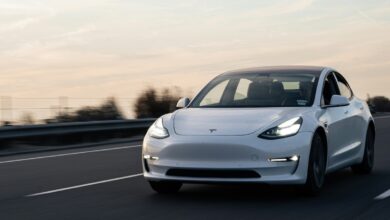February Auto Sales Slide as Demand Deflates and Vehicle Prices Climb
Consumer demand for new vehicles has fallen to its lowest level in nearly a year, as inclement weather, high vehicle costs, and growing uncertainty about the economy compel some Americans to delay their auto purchasing plans.
TechnoMetrica’s Auto Demand Index declined by 12 points, or 11 percent, in February to a score of 94, its lowest reading since March 2018. TechnoMetrica is a full-service marketing research consultancy. The company’s index has dropped below 100 in two out of the last three months, indicating a possible downtrend in vehicle purchase intent. Thus, as continuously rising transaction prices and borrowing costs price more consumers out of the auto market, TechnoMetrica anticipates that new vehicle sales will decelerate in the months ahead.
The TechnoMetrica Auto Demand Index, or ADI, was created to measure the intent of consumers to buy or lease a new vehicle within the next six months. ADI, conducted monthly, is based on the response to a key question posed to more than 900 adult Americans: How likely is it that you will buy or lease a new vehicle within the next 6 months?
The ADI has exhibited significant volatility over the last few months, suggesting that growing economic and political uncertainty is taking a toll on Americans’ intent to purchase new vehicles. February marks the third straight month in which the ADA Index has moved by double digits. After posting an 11-point decline in December, the Index rebounded last month with an increase of 10 points, before erasing this gain in February.
Trends in the Index’s moving averages indicate that the recent slowdown in auto demand will extend into the near future, according to TechnoMetrica. The three-month moving average posted its fourth straight monthly decline in February, falling four points to a score of 99. In addition, the Index’s six-month average decreased by six points to a reading of 106, the lowest since August.
The deterioration in vehicle purchase intent is further demonstrated by the ongoing downtrend in TechnoMetrica’s momentum indicator. This month, the ADI Momentum score descended into negative territory for the first time since May, dipping from zero to -1.7. Momentum for the Index has now slowed during each of the last five months, indicating that new vehicle demand will ease further in the coming months.
Affordability concerns are softening consumer demand for new vehicles, as rising costs shut a growing share of consumers out of the auto market, according to TechnoMetrica. The average transaction price of a new vehicle reached an all-time high of $37,260 in December, up from $30,662 in December 2010, a gain of 22 percent.
Borrowing has also become an increasingly expensive option for consumers, as higher interest rates create tighter credit conditions. The average interest rate on a new car loan rose to its second highest level in a decade in January, at 6.19 percent, according to Edmunds. In addition, monthly car payments have climbed to an all-time high, averaging $545 a month, per Experian.
The high costs associated with a new vehicle are creating a shift in consumer demand toward gently-used vehicles. New vehicle prices are nearly double the cost of a used vehicle, which hit an average $20,084 this past November. Further, the used vehicle market has received a glut of off-lease autos that offer most of the features of a new car, but at a much lower cost. Hence, according to Edmunds, auto retailers sold 10.4 million used vehicles during the second quarter of 2018, the highest quarterly volume on record.
“As new vehicle prices reach record levels, and car incentives continue to dry up, an increasing number of consumers are opting to postpone their purchasing plans, at least for the time being. Further, a glut of off-lease vehicles returning to the market has provided consumers with the opportunity to enjoy the new-car experience at a lower price,” said Raghavan Mayur, president of TechnoMetrica. “As a result, we expect that demand for new autos will moderate in the coming months.”
Vehicle purchase intent waned across most demographic groups this month. In all, 12 of the 19 segments that TechnoMetrica monitors on a monthly basis posted declines in the index, similar to January.
Demographics
Young adults aged 18 to 24 showed the most significant deceleration in auto demand, posting a 40-point plunge to a score of 46. The younger cohort, many of whom are embarking on their college track or starting their careers, are especially sensitive record-high new vehicle prices and tighter credit conditions.
According to Kelley Blue Book, new vehicle prices in 2018 displayed their strongest year of growth since 2013. In addition, zero financing options are becoming more rare, while automakers continue to pull back on new car incentives. As a result, younger drivers are increasingly turning to the used vehicle market for low-cost exposure to the same state-of-the-art technological features found in new cars.
A 2016 analysis of vehicle registration data conducted by Edmunds found that Generation Z shoppers purchase 6.5 times more used cars than new cars. In addition, a recent JD Power analysis concluded that Gen Z drivers prefer used vehicles with more technological features at a lower cost over small, entry-level new compact cars.
Consumers residing in the Northeast also reported steep declines in new vehicle demand, as a polar vortex brought frigid temperatures and snow to the region at the end of January. The segment dropped 20 points in the Index this month, posting a reading of 89, the lowest since March 2018. Further, this is the first time in eight months that purchase intent levels among Northeasterners have fallen below 100, indicating a freeze in auto demand.
The $30,000-$50,000 income cohort and the urban-dwelling segment each recorded a 13-point decline in the index this month. The middle-income cohort reported its lowest levels of purchase intent since September 2017, with a score of 69. In addition, February marks the third consecutive month in which the $30,000-$50,000 income group has posted a reading below 100, indicating a slump in purchase intent among the segment members.
Despite a strong economy that continues to pump out jobs at a robust pace, many middle-class families are still experiencing fragile financial situations amid rising expenses and steady wage growth. In fact, about four in 10 Americans would be unable to cover an emergency expense of $400, according to a Federal Reserve study released in May 2018.
While median income has climbed over the years, rising living costs have been eating away at these gains for many middle-class Americans. For instance, research suggests that increased health care costs are costing workers thousands of dollars a year in wages. According to a 2018 report from the Economic Policy Institute, employer-sponsored insurance premiums surged 213 percent between 1999 and 2016, from $5,791 to $18,142. In addition, a new report from Apartment Guide reveals that the average rent on an apartment jumped 4.2 percent in 2018 alone.
Thus, especially with new vehicle prices approaching record highs, consumers with moderate incomes are likely to hold off on big-ticket purchases until wage growth picks up greater momentum.
Demand for new vehicles also eased among consumers aged 45 to 64 (minus 10 points), who recorded their lowest Index score since April 2018, at 106. This age cohort has reported a 23-percent drop in purchase intent levels since reaching a multi-year high of 137 in October.
Positive Indicators
Meanwhile, six segments showed a positive change in new vehicle demand, with consumers aged 65 or older demonstrating the greatest improvement over the past month. The age group posted a nine-point gain in the index, reaching a score of 79, the highest since April.
An aging baby boomer population has given rise to a record 42 million elderly drivers (aged 65 and older) on U.S roads, according to AAA. Further, retirement-aged Americans are more likely to remain in the workforce. Between 2011 and 2016, the number of employed Americans aged 65 or older increased from 6.6 million to 8.9 million, a growth of 35 percent.
Rural Americans also reported a greater intent to purchase new vehicles. The index for the segment climbed six points this month, to a score of 112, the best performance since October 2018. Over the years, rural areas have seen stronger wage growth than their urban counterparts, likely due to the boom in U.S. oil and gas production.
New-vehicle demand also improved among consumers earning less than $30K a year, who are particularly sensitive to the continual growth in incomes. Low-earning Americans posted a five-point gain in the Index, hitting a score of 69. Still, this marks the segment’s fourth consecutive month with an Index reading below 100.
Each month, TechnoMetrica uses Random Digit Dial telephone methodology to conduct live interviews with more than 900 respondents, using both landlines and cell phones. The margin of error for the survey is +/- 3.2 percentage points.



